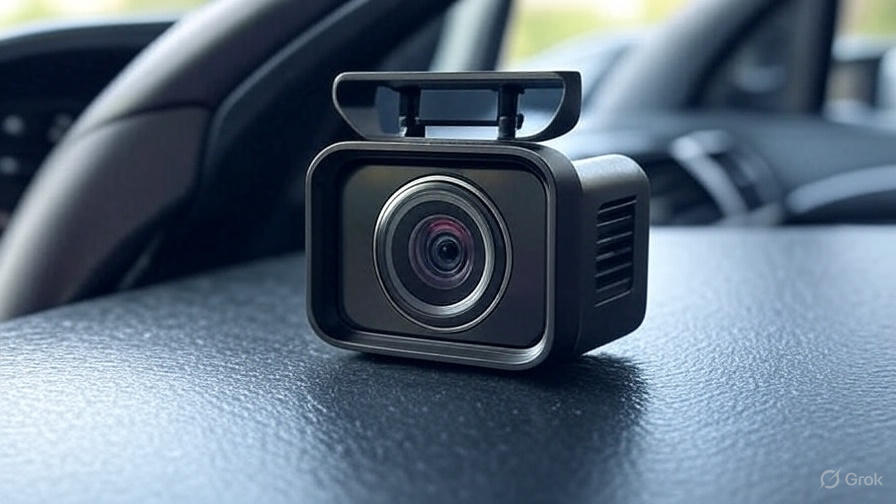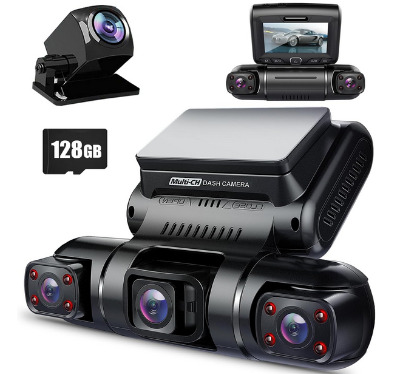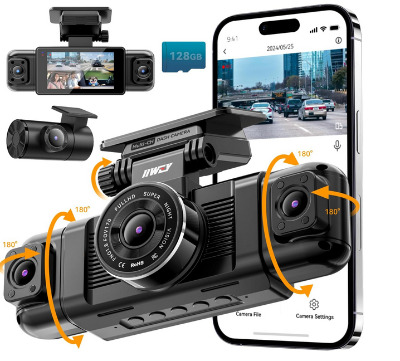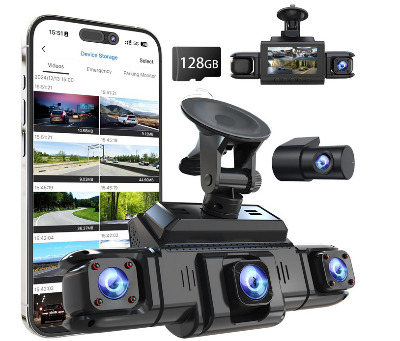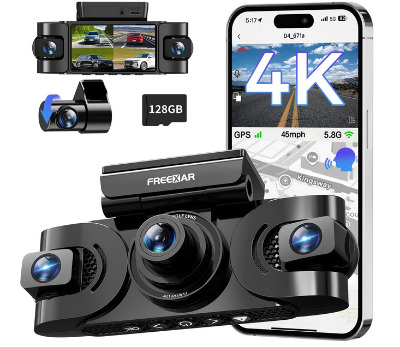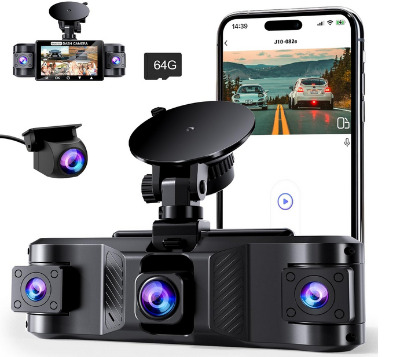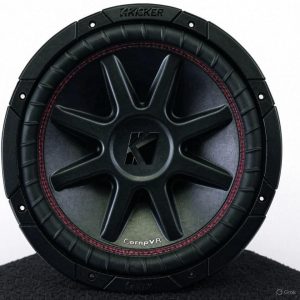Modern vehicles face increasing risks on busy roads. A standard single-camera dash cam only captures what happens directly ahead. However, incidents can occur from any direction – side collisions, rear-end crashes, or break-ins through side windows. This reality makes 4 channel dash cams essential for comprehensive vehicle protection.
A 4 channel dash cam system provides complete 360-degree coverage around your vehicle. These advanced systems record simultaneously from front, rear, left, and right perspectives. This multi-angle recording ensures no blind spots remain unmonitored. Every potential incident gets captured from multiple viewpoints, providing crucial evidence for insurance claims and legal proceedings.
The market offers numerous 4 channel dash cam options, each with unique features and capabilities. Some models excel in night vision performance, while others focus on ultra-high resolution recording. GPS tracking, WiFi connectivity, and smartphone app integration have become standard features across premium models.
This comprehensive review examines five top-performing 4 channel dash cam systems. Each product offers distinct advantages for different driving needs and budgets. The analysis covers video quality, installation complexity, software functionality, and overall value proposition.
What Makes 4 Channel Dash Cams Essential
Four-channel recording systems transform vehicle security monitoring. Traditional single-camera units leave significant coverage gaps. Side impacts, door dings in parking lots, and break-in attempts often occur outside the front camera’s field of view. Multi-channel systems eliminate these blind spots entirely.
Insurance companies increasingly recognize the value of comprehensive video evidence. Claims processing becomes faster and more straightforward when clear footage documents the entire incident. Multiple camera angles help establish fault determination in complex accidents involving several vehicles.
Professional drivers and ride-share operators find 4 channel systems particularly valuable. Taxi drivers, Uber operators, and delivery personnel face unique risks from passengers and external threats. Interior cameras monitor passenger behavior while exterior cameras track road incidents. This dual protection proves invaluable for both safety and liability concerns.
Fleet managers appreciate the comprehensive monitoring capabilities these systems provide. Employee driving behavior, vehicle maintenance needs, and route optimization all benefit from multi-angle recording data. The systems help reduce insurance premiums while improving overall fleet safety standards.
Key Features to Consider
Video resolution stands as the primary consideration when evaluating 4 channel dash cams. Higher resolution provides clearer license plate capture and facial recognition capabilities. However, increased resolution requires more storage space and processing power. The balance between quality and storage efficiency varies across different models.
Night vision performance becomes crucial for drivers who frequently travel during low-light conditions. Infrared LED arrays illuminate dark areas without creating glare that might distract drivers. The number and placement of these LEDs directly impact nighttime recording quality. Some systems feature advanced low-light sensors that enhance natural lighting conditions.
GPS functionality adds significant value beyond simple location tracking. Speed monitoring, route recording, and automatic incident marking help create comprehensive trip documentation. Insurance companies often offer discounts for vehicles equipped with GPS-enabled dash cam systems. The feature also helps recover stolen vehicles by providing location data.
WiFi connectivity enables remote video access through smartphone applications. Users can view live feeds, download recordings, and adjust camera settings without physically accessing the device. Cloud storage integration allows automatic backup of critical footage. However, data usage costs and connectivity reliability vary by location and service provider.
Parking mode monitoring protects vehicles during unattended periods. Motion detection triggers recording when the system detects movement around the parked vehicle. Some models offer continuous recording during parking, while others activate only when motion occurs. Battery life and power consumption become important factors for extended parking mode operation.
PRUVEEO 360 Degree View 4 Channel Dash Cam Review
The PRUVEEO 360-degree system delivers comprehensive vehicle monitoring through its four-camera configuration. This model combines front, rear, and side camera coverage with interior monitoring capabilities. Built-in GPS tracking provides location data for every recorded journey, while WiFi connectivity enables remote access through the companion mobile application.
Video quality reaches 1080P resolution across all four channels simultaneously. This resolution level ensures clear license plate capture during daytime conditions. The system maintains consistent recording quality even when all cameras operate concurrently. Night vision performance benefits from strategically placed infrared LED arrays that illuminate dark areas without creating driver distraction.
Installation complexity remains moderate for users with basic technical skills. The system includes comprehensive wiring harnesses and mounting hardware for all four camera positions. Professional installation may be preferred for complex vehicle configurations or users uncomfortable with electrical connections. The included 128GB storage card provides substantial recording capacity before loop recording begins.
GPS functionality tracks vehicle speed, location, and route information automatically. This data integrates with video recordings to create comprehensive incident documentation. Insurance claims benefit from the precise location and speed data that accompanies video evidence. The GPS module locks onto satellite signals quickly in most environments.
WiFi connectivity operates on standard frequency bands compatible with most smartphones. The companion application allows live viewing, video download, and camera setting adjustments. Connection stability varies based on distance from the vehicle and interference from other electronic devices. Cloud storage integration provides automatic backup for critical recordings.
Parking mode monitoring activates automatically when the vehicle ignition turns off. Motion detection triggers recording when movement occurs around the parked vehicle. The system conserves battery power by entering sleep mode during extended inactivity periods. Hardwired installation enables continuous parking mode operation without draining the vehicle battery.
The PRUVEEO system excels in providing comprehensive coverage at a competitive price point. Video quality meets expectations for insurance and legal purposes. GPS integration adds valuable context to recorded incidents. However, night vision performance lags behind premium models in extremely dark conditions. Overall build quality appears solid with proper installation and maintenance.
IIWEY N5 4 Channel Dash Cam Analysis
The IIWEY N5 system distinguishes itself through enhanced night vision capabilities and advanced connectivity options. Eight infrared LED lamps provide superior illumination for dark environment recording. The system records at 1080P resolution across all channels while maintaining consistent performance during extended operation periods.
Five-gigahertz WiFi connectivity offers faster data transfer speeds compared to standard frequency bands. Video download times decrease significantly when accessing recordings through the smartphone application. The advanced WiFi implementation reduces interference from other wireless devices commonly found in vehicles. App control functionality includes live viewing, setting adjustments, and remote recording activation.
Interior camera positioning captures passenger activity and driver behavior effectively. This feature proves particularly valuable for ride-share operators and professional drivers. The camera angle covers most of the passenger compartment while avoiding driver privacy concerns. Recording quality remains consistent regardless of interior lighting conditions.
G-sensor technology detects sudden impacts and automatically locks critical footage to prevent overwriting. Sensitivity levels adjust through the mobile application to reduce false triggers from road vibrations or aggressive driving. The system distinguishes between normal driving conditions and actual collision events. Locked files receive protection from loop recording deletion.
Parking mode operation provides continuous monitoring during vehicle storage periods. The system balances comprehensive coverage with battery conservation through intelligent power management. Motion detection accuracy reduces false triggers while maintaining sensitivity to genuine security threats. Installation complexity requires professional assistance for optimal hardwired parking mode functionality.
Night vision performance exceeds many competing models through the eight-LED illumination system. License plate capture remains clear at reasonable distances even in complete darkness. However, extreme weather conditions can impact infrared effectiveness. The system compensates through automatic exposure adjustments and enhanced sensor sensitivity.
The IIWEY N5 offers excellent value for users prioritizing night vision performance and advanced connectivity. Build quality appears robust with proper installation procedures. The comprehensive feature set addresses most common dash cam requirements. However, the learning curve for full feature utilization may challenge less technical users.
360 View 4 Channel System Evaluation
This 360-degree coverage system emphasizes wide-angle recording capabilities and advanced storage technology. The 160-degree wide-angle lenses capture more of the surrounding environment compared to standard dash cam configurations. WDR technology balances exposure levels in challenging lighting conditions, ensuring clear recordings during sunrise and sunset periods.
GPS integration provides precise location tracking with fast satellite acquisition times. Route recording creates detailed journey logs that prove valuable for business expense tracking and fleet management applications. The system timestamps all recordings with location data, creating comprehensive incident documentation. Speed monitoring helps drivers maintain awareness of velocity in various traffic situations.
Five-gigahertz WiFi band operation reduces interference and improves data transfer reliability. The advanced wireless implementation supports multiple device connections for fleet management scenarios. Smartphone application functionality includes camera configuration, video playback, and system status monitoring. Cloud storage compatibility enables automatic backup of critical recordings.
Supercapacitor technology replaces traditional lithium-ion batteries for enhanced reliability in extreme temperatures. This power management approach ensures consistent operation in both hot summer and cold winter conditions. The supercapacitor maintains sufficient power for emergency recording even after engine shutdown. Temperature tolerance exceeds conventional battery-powered systems significantly.
Parking mode monitoring operates continuously when properly hardwired to vehicle electrical systems. Motion detection algorithms distinguish between relevant security threats and environmental factors like wind or passing traffic. The system conserves power during inactive periods while maintaining readiness for immediate activation. Battery drain concerns decrease through efficient power management design.
Video quality meets industry standards for legal and insurance documentation purposes. The wide-angle coverage reduces blind spots compared to narrower lens systems. However, distortion at image edges may affect distant object clarity. Night vision performance proves adequate for most urban driving environments but struggles in rural areas without street lighting.
Installation complexity varies depending on vehicle type and desired hardwiring configuration. Professional installation ensures optimal camera positioning and electrical connections. The included 128GB storage card provides extensive recording capacity before loop recording begins. Overall system reliability appears strong with proper installation and maintenance procedures.
4K 360° Dash Cam Premium Review
The 4K resolution capability sets this system apart from standard 1080P alternatives. Ultra-high definition recording provides exceptional detail for license plate capture and incident documentation. However, 4K recording requires significantly more storage space and processing power compared to lower resolution options. The system balances quality with storage efficiency through intelligent compression algorithms.
Voice control functionality enables hands-free operation while driving. Simple voice commands start recording, capture photographs, or adjust basic settings without manual interaction. This feature enhances driver safety by reducing distraction from device operation. Voice recognition accuracy varies based on ambient noise levels and command clarity.
GPS tracking includes advanced features like speed limit warnings and route optimization suggestions. The system compares current vehicle speed with posted limits and provides audio alerts for violations. This functionality helps drivers maintain legal compliance while creating documentation of responsible driving behavior. Insurance companies may offer discounts for vehicles equipped with such monitoring systems.
5.8GHz WiFi operation provides faster data transfer and reduced interference compared to standard frequency bands. Video download speeds increase substantially when accessing recordings through mobile devices. The advanced wireless implementation supports simultaneous connections from multiple devices for fleet management applications. App functionality includes live streaming, remote configuration, and automated cloud backup.
Night vision technology combines infrared illumination with low-light sensor enhancement. The dual approach improves recording quality in various dark conditions from urban street lighting to rural environments. However, extreme weather conditions like heavy rain or snow can impact infrared effectiveness. The system compensates through automatic exposure adjustments and advanced noise reduction.
Twenty-four-hour parking mode requires hardwired installation for continuous operation. Motion detection triggers immediate recording while conserving battery power during inactive periods. The system distinguishes between security threats and environmental factors through advanced algorithms. False trigger reduction improves through software updates and user feedback integration.
Installation complexity exceeds basic plug-and-play systems due to advanced feature requirements. Professional installation ensures optimal performance and warranty protection. Proper camera positioning becomes critical for 4K resolution benefits. The learning curve for full feature utilization may challenge users unfamiliar with advanced dash cam technology.
The 4K system justifies its premium price through exceptional video quality and comprehensive features. Users who require maximum recording detail will appreciate the ultra-high definition capability. However, storage requirements and complexity may overwhelm casual users seeking basic dash cam functionality.
4 Channel 2.5K System Comparison
The 2.5K resolution option provides a middle ground between standard 1080P and premium 4K systems. This resolution level offers improved detail capture without the extreme storage requirements of ultra-high definition recording. Video quality proves sufficient for most insurance and legal applications while maintaining reasonable file sizes.
170-degree wide-angle coverage captures more of the surrounding environment compared to narrower lens configurations. The expanded field of view reduces blind spots and provides better context for recorded incidents. However, some image distortion occurs at the edges of the wide-angle coverage area. Overall recording quality remains acceptable for documentation purposes.
Five-gigahertz WiFi connectivity ensures fast data transfer and reduced interference from other wireless devices. The advanced wireless implementation supports reliable connections even in electronically dense environments. Smartphone application functionality includes live viewing, video download, and system configuration options. Connection stability exceeds standard frequency band alternatives significantly.
G-sensor technology detects collision impacts and automatically protects relevant footage from deletion. Sensitivity adjustments through the mobile application help reduce false triggers from road conditions or aggressive driving. The system learns from user feedback to improve impact detection accuracy over time. Locked files remain protected during loop recording cycles.
Super night vision capabilities combine infrared LED arrays with enhanced sensor technology. Recording quality remains acceptable in most low-light conditions encountered during normal driving. However, performance varies based on environmental factors and weather conditions. License plate capture distance decreases in extremely dark rural environments.
Loop recording management prevents storage overflow while preserving critical footage. The system automatically overwrites oldest files when storage capacity reaches maximum levels. However, important recordings require manual protection to prevent accidental deletion. User education becomes important for optimal system operation and file management.
Parking mode monitoring operates through motion detection when the vehicle remains stationary. The system balances security monitoring with battery conservation through intelligent power management. Installation requirements include hardwiring for extended parking mode operation. Professional installation ensures proper electrical connections and optimal performance.
The 2.5K system offers balanced performance for users seeking improved video quality without premium pricing. Build quality appears solid with appropriate installation and maintenance. Feature sets address most common dash cam requirements while remaining accessible to average users.
Installation and Setup Considerations
Professional installation provides optimal performance and warranty protection for complex 4 channel systems. Proper camera positioning ensures maximum coverage while avoiding driver vision obstruction. Electrical connections require expertise to prevent vehicle electrical system damage. Hardwired parking mode installation involves accessing vehicle fuse boxes and routing power cables.
Self-installation remains possible for technically inclined users with appropriate tools and patience. Comprehensive instruction manuals guide users through camera mounting and cable routing procedures. However, warranty coverage may be affected by improper installation or electrical connections. Vehicle modifications should be documented for insurance and resale considerations.
Camera positioning significantly impacts recording effectiveness and system performance. Front cameras require clear windshield mounting without wiper interference. Rear cameras need positioning that avoids backup camera conflicts and lighting interference. Side cameras must balance coverage with aerodynamic considerations and vehicle aesthetics.
Cable routing requires careful planning to avoid interference with vehicle operation. Professional installers understand optimal routing paths that minimize visibility while ensuring reliable connections. Improper cable management can create safety hazards or system reliability issues. Weather sealing becomes critical for exterior connections and camera housings.
System configuration through mobile applications enables customization for specific driving requirements. Video quality settings balance recording detail with storage capacity management. Sensitivity adjustments for motion detection and G-sensor operation reduce false triggers. Regular software updates improve performance and add new features over time.
Storage and File Management
Storage capacity directly impacts recording duration before loop recording begins overwriting older files. Higher resolution recording consumes storage space more rapidly than standard definition alternatives. The included storage cards provide baseline capacity, but users may require larger cards for extended recording periods. Class 10 or better storage cards ensure reliable high-speed data writing.
Loop recording prevents storage overflow by automatically overwriting oldest files when capacity reaches maximum levels. This system ensures continuous recording operation without manual intervention. However, important footage requires protection through manual locking or immediate download. User education becomes essential for preventing accidental loss of critical recordings.
File organization systems vary among different dash cam manufacturers and models. Some systems create folders by date or event type for easier navigation. Others rely on timestamp information for file identification. Mobile applications typically provide search and filter functions to locate specific recordings quickly. Cloud storage integration offers automatic backup for protected files.
Video compression technology balances file size with recording quality across different systems. Advanced compression algorithms reduce storage requirements while maintaining acceptable video quality. However, extreme compression can impact detail clarity for critical evidence applications. Users must balance storage efficiency with quality requirements for their specific needs.
Regular storage maintenance prevents system slowdowns and ensures reliable operation. Periodic formatting of storage cards eliminates fragmented files and optimizes performance. However, formatting destroys all stored recordings unless previously backed up. Scheduled maintenance routines help maintain optimal system performance over extended periods.
Power Management and Battery Life
Hardwired installation enables continuous parking mode operation without draining vehicle batteries. Professional installation includes battery monitoring circuits that prevent complete battery discharge. The systems automatically shut down when battery voltage drops below safe operating levels. This protection prevents vehicle starting problems while maintaining security monitoring capabilities.
Capacitor-based power systems offer enhanced reliability compared to traditional lithium-ion battery alternatives. Supercapacitors tolerate extreme temperatures better while providing consistent power delivery. However, capacitor systems typically provide shorter backup power duration during electrical system failures. The trade-off between reliability and backup duration varies among different models.
Power consumption varies significantly based on recording resolution and active features. 4K recording requires more processing power and energy compared to 1080P alternatives. WiFi connectivity, GPS tracking, and parking mode monitoring each contribute to overall power requirements. Energy-efficient designs help minimize impact on vehicle electrical systems.
Battery protection circuits monitor vehicle electrical system health and adjust power consumption accordingly. The systems reduce feature operation when battery voltage drops below optimal levels. Complete shutdown occurs before battery discharge reaches levels that would prevent vehicle starting. Recovery protocols restore full operation when electrical system health improves.
Solar panel integration offers alternative power sources for extended parking mode operation. Aftermarket solar solutions can supplement vehicle electrical systems for continuous monitoring. However, solar effectiveness varies based on parking location and weather conditions. Professional installation ensures optimal solar panel positioning and electrical integration.
Legal and Insurance Implications
Video evidence from 4 channel dash cams provides comprehensive incident documentation for insurance claims and legal proceedings. Multi-angle coverage eliminates disputes about fault determination in complex accidents. However, privacy laws vary by jurisdiction regarding recording of public spaces and individuals. Users must understand local regulations governing dash cam operation and video recording.
Insurance companies increasingly recognize dash cam evidence for claims processing and premium discounts. Clear video documentation speeds claim resolution and reduces dispute frequency. Some insurers offer specific discounts for vehicles equipped with GPS-enabled dash cam systems. However, insurance benefits vary by company and policy type.
Employee monitoring through dash cam systems requires compliance with workplace privacy laws and labor regulations. Fleet operators must inform drivers about monitoring systems and data usage policies. Union agreements may include provisions regarding employee monitoring and data access rights. Legal consultation becomes advisable for commercial fleet implementations.
Data ownership and access rights vary among different dash cam manufacturers and service providers. Cloud storage services may retain rights to uploaded content or require data sharing for service improvement. Users should review privacy policies and data handling procedures before system activation. International data transfer regulations may affect cloud storage options.
Court admissibility of dash cam evidence depends on proper chain of custody documentation and technical reliability proof. Original file formats and timestamps must remain intact for legal proceedings. Professional installation and maintenance documentation support evidence reliability claims. Expert witness testimony may be required to explain technical aspects of video evidence.
Maintenance and Troubleshooting
Regular cleaning of camera lenses ensures optimal recording quality throughout system operation periods. Road dirt, precipitation, and environmental contaminants can degrade video clarity significantly. Appropriate cleaning materials prevent lens scratching while removing obstructions effectively. Scheduled maintenance routines help maintain consistent performance over extended periods.
Software updates improve system performance and add new features over time. Manufacturers release updates through mobile applications or direct download from support websites. However, update procedures vary among different brands and models. Users should maintain current software versions for optimal reliability and feature access.
Storage card maintenance prevents data corruption and ensures reliable recording operation. Periodic formatting eliminates fragmented files and optimizes write performance. However, formatting destroys all stored content unless previously backed up. High-quality storage cards from reputable manufacturers reduce failure rates significantly.
Electrical connection maintenance becomes critical for hardwired installations and parking mode operation. Corrosion prevention and secure connections ensure reliable power delivery and data transmission. Professional inspection during routine vehicle service helps identify potential issues before system failures occur. Weather sealing inspection protects connections from moisture and contaminants.
Common troubleshooting procedures address frequent user issues and system problems. Power cycling resolves many software-related problems and connection issues. Factory reset procedures restore default settings when configuration problems occur. However, reset procedures may delete custom settings and require reconfiguration for specific user requirements.
Cost Analysis and Value Comparison
Entry-level 4 channel systems provide basic multi-angle coverage at accessible price points. These systems typically offer 1080P recording, basic GPS functionality, and standard WiFi connectivity. However, advanced features like superior night vision, voice control, and premium build quality require higher investment levels. Budget systems serve casual users seeking basic comprehensive coverage.
Premium models justify higher costs through enhanced video quality, advanced features, and superior build quality. 4K recording capability, voice control, and advanced parking mode monitoring appeal to users requiring maximum functionality. However, the complexity and feature density may overwhelm casual users seeking straightforward operation. Professional drivers and fleet operators typically benefit most from premium feature sets.
Installation costs vary significantly based on system complexity and professional service requirements. Basic plug-and-play systems minimize installation expenses but may lack optimal performance. Hardwired installations with parking mode functionality require professional expertise and increase overall system costs. However, proper installation ensures warranty protection and optimal performance levels.
Long-term operating costs include storage card replacements, software updates, and potential cloud storage subscriptions. Higher resolution recording accelerates storage card wear and may require more frequent replacements. Cloud storage services provide automatic backup but add ongoing subscription costs. Total cost of ownership extends beyond initial purchase price significantly.
Insurance premium discounts may offset system costs over time for qualifying policies and providers. GPS-enabled systems with comprehensive recording capabilities often qualify for maximum discount levels. However, discount availability varies by insurance company and policy type. Users should verify discount eligibility before purchase to ensure expected cost benefits.
Future Technology Trends
Artificial intelligence integration will enhance automatic incident detection and evidence protection capabilities. Machine learning algorithms can identify collision events, aggressive driving behavior, and security threats automatically. Predictive analysis may warn drivers of potential hazards based on traffic patterns and environmental conditions. However, AI functionality requires significant processing power and may increase system complexity.
Cloud connectivity improvements will enable real-time monitoring and immediate incident notification. Fleet managers can receive instant alerts when vehicles experience accidents or security breaches. Remote monitoring capabilities extend beyond simple video access to comprehensive vehicle health monitoring. However, cellular data costs and coverage reliability vary by location and service provider.
Integration with vehicle safety systems will create comprehensive protection networks combining dash cams with advanced driver assistance features. Collision avoidance systems can trigger automatic video protection and emergency response notifications. Vehicle-to-vehicle communication may share incident warnings among nearby equipped vehicles. However, integration complexity requires manufacturer cooperation and standardized protocols.
Higher resolution recording capabilities will continue improving with 8K video becoming accessible in premium systems. Ultra-high definition provides exceptional detail for evidence collection and incident analysis. However, storage requirements and processing power demands increase exponentially with resolution improvements. Balanced implementations will optimize quality with practical storage limitations.
Biometric integration may add driver identification and health monitoring capabilities to comprehensive dash cam systems. Driver fatigue detection and medical emergency recognition could trigger automatic emergency response. However, privacy concerns and regulatory compliance become more complex with biometric data collection. User acceptance varies based on privacy expectations and security requirements.
Final Recommendations
The PRUVEEO 360 Degree system offers excellent value for users seeking comprehensive coverage with reliable GPS functionality. Video quality meets most insurance and legal requirements while maintaining reasonable storage consumption. Built-in WiFi enables convenient smartphone access, and the included 128GB card provides substantial recording capacity. However, night vision performance may disappoint users frequently driving in dark conditions.
Users prioritizing superior night vision should consider the IIWEY N5 system with its eight infrared LED array. The enhanced illumination system provides clear recording in most low-light conditions encountered during normal driving. Five-gigahertz WiFi connectivity offers improved data transfer speeds and reduced interference. G-sensor functionality protects critical footage automatically during collision events.
The 4K 360° system justifies premium pricing for users requiring maximum video quality and advanced features. Ultra-high definition recording provides exceptional detail for critical evidence applications. Voice control functionality enhances driver safety by reducing distraction during operation. However, storage requirements and system complexity may challenge casual users seeking straightforward functionality.
Budget-conscious users should evaluate the 2.5K system for balanced performance without premium pricing. The resolution level provides improved detail compared to standard 1080P while maintaining reasonable storage requirements. Wide-angle coverage reduces blind spots effectively, and super night vision capabilities handle most low-light conditions. Loop recording management prevents storage overflow automatically.
Fleet operators and professional drivers benefit most from comprehensive 4 channel systems regardless of specific model selection. Multi-angle coverage eliminates blind spots while GPS tracking provides valuable business documentation. Parking mode monitoring protects valuable commercial vehicles during unattended periods. Insurance premium discounts often offset system costs over time for commercial applications.
The investment in a quality 4 channel dash cam system provides long-term value through enhanced security, insurance protection, and peace of mind. Comprehensive coverage eliminates recording gaps that single-camera systems cannot address. Professional installation ensures optimal performance and warranty protection for complex systems. Regular maintenance and proper operation maximize system reliability and recording quality over extended service periods.

